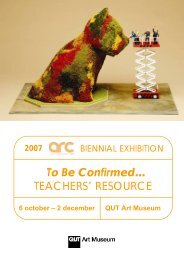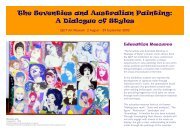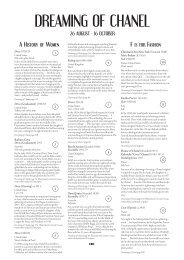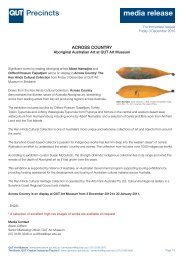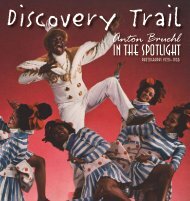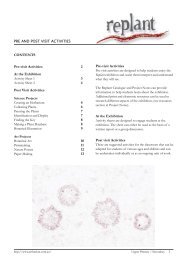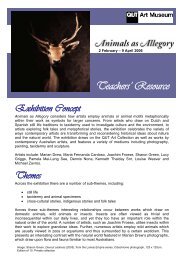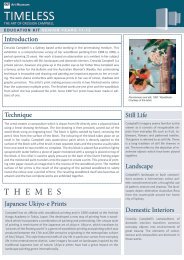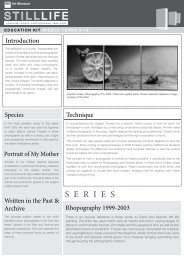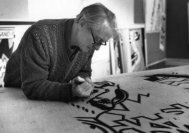Senior Years (10-12) [pdf - 4.5 MB] - QUT Art Museum
Senior Years (10-12) [pdf - 4.5 MB] - QUT Art Museum
Senior Years (10-12) [pdf - 4.5 MB] - QUT Art Museum
Create successful ePaper yourself
Turn your PDF publications into a flip-book with our unique Google optimized e-Paper software.
A guide to this resource<br />
This resource provides valuable support for educators wishing to include UnAustralian: Reimaging National<br />
Identity in their Visual <strong>Art</strong>s program. It includes easy to read notes that can be used directly in the classroom<br />
and sample activities for use before, during, and after a visit to the exhibition.<br />
The Queensland Studies Authority outlines a series of Global Aims for a course of study developed for use in<br />
the Visual <strong>Art</strong>s. This resource draws from these aims, and supports the Inquiry Learning Model. It specifically<br />
encourages students to:<br />
> Appraise artworks, with confidence and individuality<br />
> Recognise and respect the personal aesthetic of others<br />
> Affirm and value the contributions of visual artists, engaging with Australian art<br />
> Examine perspectives relating to social, spiritual, environmental and vocational contexts<br />
> Be appreciative of multiple perspectives and philosophies on the meanings of artworks<br />
> Embrace contemporary visual arts practices<br />
> Create informed, active and sustained engagement with the visual arts.<br />
Although these resources are developed with Visual <strong>Art</strong>s students in mind, there are many aspects relevant to<br />
other Key Learning Areas such as English and Studies of Society and Environment.<br />
Cover image: Marian Drew<br />
Pelican with turnips, 2005<br />
Colour giclée print<br />
Purchased 2006 through the Betty Quelhurst Fund<br />
The content of this Resource was developed from the Queensland Studies Authority syllabus for <strong>Senior</strong> Visual<br />
<strong>Art</strong> (ISBN: 978-1-920749-44-6) and the Queensland Studies Authority’s Year <strong>10</strong> guidelines for The <strong>Art</strong>s. This<br />
Resource was produced by <strong>QUT</strong> <strong>Art</strong> <strong>Museum</strong>, <strong>QUT</strong> Precincts.
Introduction<br />
The exhibition<br />
“There is no ‘real’ Australia waiting to be<br />
uncovered. A national identity is an invention.”<br />
Richard White, 1981<br />
Since the late 1990s the term un-Australian has been<br />
used freely, appearing everywhere from front bench<br />
politics to the sporting arena. But what does it mean<br />
to be unAustralian? The term implies that there are<br />
fundamental characteristics shared across our society<br />
that bind us as Australians regardless of our diversity,<br />
and to be un-Australian is to challenge this. However,<br />
cultural stereotypes aside, is there a national identity<br />
that reflects the reality of our everyday lives or is it<br />
simply a myth?<br />
Utilising works drawn from the <strong>QUT</strong> <strong>Art</strong> Collection,<br />
UnAustralian: Reimaging National Identity<br />
reflects on the role that art plays in confirming and<br />
challenging ideas of national identity and how we<br />
revisit, retell and repurpose enduring national stories.<br />
What is national identity?<br />
National identity is a concept that attempts to<br />
connect the population of a country by promoting<br />
national stories and ideas that make everyone feel<br />
as if they have a shared sense of history and destiny.<br />
National identity encourages them to act in ways that<br />
benefit the community, not just themselves.<br />
When trying to define what it means to be Australian<br />
we discover more questions than answers. This is<br />
because each one of us could describe ourselves as<br />
having various different identities that depend on<br />
things such as ethnicity, culture, religion, gender,<br />
sexuality or class. We could even say that our identity<br />
changes many times throughout our life as we<br />
experience new things.<br />
<strong>Art</strong> shares a very close relationship with nationalism.<br />
It can confirm and challenge our national stories.<br />
Some artworks visually present important events in<br />
our history to commemorate and record them. Other<br />
artworks present new stories that aren’t well known,<br />
or a different version of an existing story.<br />
Margaret DODD born 1941<br />
On top of old faithful 1972<br />
Earthenware ceramic sculpture,<br />
hand built with onglaze enamels and<br />
silver lustre<br />
Purchased 1972<br />
1
UnAustralian<br />
Without really thinking about it we all really know<br />
what it means to be Australian. Positive stories about<br />
being Australian are all around us. If we know what<br />
it means to be a ‘good’ Australian then what is the<br />
opposite of this?<br />
The term that is used to describe this is unAustralian.<br />
It was first used during the 1850s however it became<br />
very common from the mid 1990s. The term has<br />
changed in meaning over this time. Firstly, it was<br />
used in the areas of art and literature for defining<br />
something that wasn’t Australian in character.<br />
Throughout the 1990s the term became more<br />
negative, suggesting behaviour, belief or policy that<br />
was against the Australian way of life. As the term has<br />
become more common over the years, it has become<br />
less offensive and more sarcastic.<br />
Bashir BARAKI 1943-98<br />
Footballers in scrum with the horses (from the Australian football series)<br />
1996-98<br />
Six colour laser prints<br />
Purchased 1997-1998<br />
2
Myths, icons & legends<br />
Luke ROBERTS born 1952<br />
Ned + Nolan (from 1+1=8) 2001<br />
Twelve giclée prints from a<br />
photographic performance series,<br />
1988-93<br />
Purchased 2002<br />
Ned Kelly<br />
Edward ‘Ned’ Kelly was a notorious Australian<br />
bushranger; he was arrested several times in his youth<br />
for assault, and was later caught after playing part<br />
in a cattle-rustling operation. Eventually Kelly and<br />
his gang attempted bolder crimes: robbing banks<br />
and taking hostages. After an acquaintance of the<br />
gang was found to be a police informant and killed,<br />
the Kelly gang took around seventy hostages at the<br />
Glenrowan Inn, knowing that a train loaded with<br />
police was approaching. The gang donned their<br />
famous armour in preparation for the attack, but were<br />
overwhelmed by the police after a plan to derail the<br />
train failed. All of the members of the Kelly gang were<br />
killed in the incident except for Ned Kelly himself.<br />
He was tried and hanged on November 11, 1880.<br />
The myths and stories associated with outlaws or<br />
‘social bandits’ are important to building national<br />
identity. Long after his death, Kelly has appeared<br />
in various cultural situations including visual art,<br />
literature and film. He also made a public appearance<br />
at the opening ceremony of the Sydney 2000<br />
Olympic Games. He is portrayed as a positive<br />
symbol of Australian identity, standing up for the<br />
‘underdog’ regardless of the fact that he was a<br />
criminal.<br />
Wandjina<br />
Traditionally found in the Kimberley region in<br />
northern Western Australia, the Wandjina figure,<br />
which are believed to be spirit ancestors, are primarily<br />
characterized by their imposing size, large eyes and<br />
nose, but no mouth. Traditional rock paintings<br />
featuring Wandjina are believed to be marks placed<br />
by the spirit ancestors themselves and it is the<br />
Indigenous custodians’ responsibility to repaint these<br />
images again and again to keep them fresh.<br />
In Perth during 2006 Wandjina figures began<br />
appearing in the form of graffiti. These images<br />
engaged the local community, with Perth people<br />
taking up “Wandjina Watching”, documenting<br />
the phenomena by photographing the graffiti and<br />
uploading it onto a community website.<br />
The use of this sacred Indigenous image in<br />
contemporary street art angered elders from the<br />
Kimberley and raised questions about what is<br />
considered vandalism and what is considered<br />
culture. Today, some contemporary artists who<br />
are descendants from the Kimberley region are<br />
allowed to produce Wandjina images as art, however<br />
unauthorised use of these images is not looked upon<br />
kindly by the Kimberley elders and other members<br />
of the community. In the end, the individual graffiti<br />
artist who was painting the Wandjina revealed his/<br />
her identity to the Kimberley elders, who requested<br />
the artist stop painting the figures.<br />
3
Place & space<br />
Our relationship with land and space is very<br />
important to our understanding of national identity.<br />
Our natural environment is what tells us apart from<br />
other nations and therefore is regularly used as a<br />
metaphor for uniqueness. In the case of Australia, the<br />
outback and the beach are popularly seen as our most<br />
defining features.<br />
LEFT<br />
Rosalie GASCOIGNE 1917-99<br />
Grassfest 1999<br />
Assemblage of sawn wooden soft<br />
drink crates on plywood<br />
Purchased 1999<br />
RIGHT<br />
Claude PANNKA 1928-72<br />
Luritja language group<br />
Central Australian landscape c1963<br />
Watercolour<br />
Purchased 2006<br />
The country<br />
Outback: Australian: the remote and usually<br />
uninhabited inland districts.<br />
In many ways the outback is presented as the ‘real’<br />
Australia regardless of the fact that most Australian’s<br />
live and work in cities, suburbs and regional centres.<br />
It is mythologised in many non Indigenous stories<br />
in two ways. Firstly, as a pure and authentic place,<br />
untainted by Western influence and secondly, as a site<br />
of fear, terror and hardship.<br />
Terra nullius<br />
Terra nullius is Latin for “land belonging to no one”.<br />
It refers to the legal concept that when the first<br />
Europeans arrived in Australia the land was owned by<br />
no one and therefore open to settlement.<br />
Indigenous imagery is all around us today, yet it took<br />
until 1967 before Aboriginal people were accorded<br />
basic citizenship rights and were counted in the<br />
National Census of the Australian people. Prior to<br />
this, Aboriginal people were not even counted as<br />
citizens. It was not until the High Court’s Mabo v<br />
Queensland decision in 1992, that ‘terra nullius’ was<br />
not recognised by the common law.<br />
4
The beach<br />
Most of Australia’s population lives close to the<br />
coastline and the beach has long occupied a special<br />
place in the Australian identity. All Australian<br />
beaches are public places and for many it is a desired<br />
recreational destination for sun and fun. However<br />
throughout recorded history and even in the recent<br />
past the beach has also seen disaster, tragedy and<br />
conflict.<br />
Tom RISLEY born 1947<br />
Coral trout 1983<br />
Thong fragments on weathered<br />
plywood<br />
Purchased 1983<br />
Davida ALLEN born 1951<br />
Anna head, still life and Boonah<br />
painting no. 2 1980<br />
Oil on canvas<br />
Purchased 1981<br />
The suburbs<br />
Earlier representations of Australian national<br />
identity centred on the rural, country and bush<br />
environments. Given that some 85% of Australians<br />
live in urban areas, it is not surprising that over time<br />
representations of people and place have changed<br />
to focus on suburban Australian life. Suburbia is one<br />
of the ways that Australia is internationally know<br />
given that a lot television programs that are exported<br />
overseas focus on life in the suburbs [Kath and Kim<br />
and Neighbours].<br />
The suburbs are seen in different ways by different<br />
people. They are places of great aspiration; to own<br />
a land and house brings a feeling of security and<br />
belonging to the owner/s. They are also criticised as<br />
being repetitive, ordinary and boring; not reflective of<br />
the diversity of the people that live there.<br />
5
Focus works<br />
6<br />
John Coburn: Kakadu<br />
‘My aim is to create formal harmonies of shapes and<br />
colours that exist in their own right and at the same<br />
time distil the essence of a place…Vital art must be<br />
a natural outpouring of one’s experience disciplined<br />
by form’<br />
John Coburn<br />
A dedicated abstractionist, Coburn’s art emanated<br />
from a contemplative place - his wish to express<br />
a quiet spiritualism through painting. His highly<br />
emblematic forms are imbued with a sense of<br />
peace and organic vitality. Their condensed<br />
nature alludes to the transcendental mysteries of<br />
nature as a means of defining human existence.<br />
During 1987 Coburn visited the Northern<br />
Territory – Kakadu, Alice Springs and the Gulf<br />
Country. He said at the time: “We come from<br />
a European culture – we have been here 200<br />
years. It’s time for us to relate to the land as the<br />
Aborigines do and have the same feeling for it.”<br />
The painting you see here, Kakadu 1990 was<br />
inspired by this journey.<br />
John Coburn: Spirit of Abstraction Australian <strong>Art</strong><br />
Collector Issue October 2000 p.96-<strong>10</strong>0.<br />
Gordon BENNETT born 1955<br />
Big baroque painting (The inland sea) 1995<br />
Synthetic polymer paint and oil on canvas<br />
Purchased 1995 with the assistance of the Vice-Chancellor’s Special Initiatives<br />
Fund in celebration of the Collection’s fiftieth anniversary<br />
Gordon Bennett: Big Baroque Painting<br />
(The inland sea)<br />
Throughout his career, Gordon Bennett has<br />
consistently dealt with the issue of identity, in<br />
particular focussing on the tensions of identity<br />
within contemporary Australia. His practice is<br />
strongly influenced by deconstruction theory<br />
and realised through forms of post-modern<br />
appropriation which challenges conventional<br />
ways of viewing the subject matter he explores.<br />
In many ways this work is both landscape and<br />
seascape. The dominant colours of yellow, ochres<br />
and red hark to that of the desert however there<br />
are also motifs of the sea; rolling waves and an<br />
upturned boat. By way of appropriation, Bennett<br />
often references Australian and international<br />
artists in his work. In the case of Big Baroque<br />
Painting (The inland sea) we can see explicit<br />
references to the American abstractionist Jackson<br />
Pollock, through characteristic splatters in the<br />
left and Roy Lichtenstein through the yellow<br />
and red graphic brush strokes that sweep across<br />
the painting. In contrast to this black handprints<br />
found at the top right of the painting signify the<br />
presence of Indigenous people and culture.<br />
Another reoccurring motif in Bennett’s work is<br />
the perspective grid. This system has long been<br />
used for organising visual information and to<br />
assist in depicting three dimensional space on a<br />
two dimensional plane. In Big Baroque Painting<br />
(The inland sea) we find a solitary Indigenous<br />
man in the lower left corner seated on a grid. The<br />
grid highlights the controlled order and structure<br />
of knowledge systems in Western culture, and<br />
how these influence ones understanding of<br />
self. In particular Bennett is interested in how<br />
these systems have impacted on Indigenous<br />
Australians.
List of works<br />
Tony ALBERT born 1981<br />
Girramay/Kuku Yalanji language groups<br />
Welcome to Australia 2009<br />
Archival digital print on 300gsm<br />
splendorgel digital paper stock with hand<br />
coloured title page and <strong>10</strong> piece texta set<br />
Purchased 2009<br />
Davida ALLEN born 1951<br />
Anna head, still life and Boonah painting no. 2<br />
1980<br />
Oil on canvas<br />
Purchased 1981<br />
Bashir BARAKI 1943-98<br />
Australian football series 1996-98<br />
Six colour laser prints<br />
Purchased 1997-1998<br />
Gordon BENNETT born 1955<br />
Big baroque painting (The inland sea) 1995<br />
Synthetic polymer paint and oil on canvas<br />
Purchased 1995 with the assistance of the<br />
Vice-Chancellor’s Special Initiatives Fund<br />
in celebration of the Collection’s fiftieth<br />
anniversary<br />
The betrayal (Pieces of silver) 1989<br />
Photographic reproduction, oil and<br />
synthetic polymer paint on paper mounted<br />
on composition board<br />
Purchased 1989<br />
Ian BURN 1939-93<br />
Systematically altered photographs: Suburban<br />
Sunday; Canberra Shopping Centre; Popular<br />
Torrens Lake, Adelaide; Text ‘It seems, in my<br />
seeing…’ 1968<br />
Four photo-lithographs<br />
Purchased 2006<br />
John COBURN 1925-2006<br />
Kakadu 1990<br />
Oil on canvas<br />
Gift of John and Doreen Coburn under the<br />
Cultural Gifts Program, 1998<br />
<strong>QUT</strong> <strong>Art</strong> Collection<br />
Juan DAVILA born 1946<br />
Bretonism 1989<br />
Colour screenprint<br />
Purchased 1995<br />
Margaret DODD born 1941<br />
On top of old faithful 1972<br />
Earthenware ceramic sculpture, hand built<br />
with onglaze enamels and silver lustre<br />
Purchased 1972<br />
Marian DREW born 1960<br />
Pelican with turnips 2005<br />
Magpie with Paw Paw 2005<br />
Colour giclée prints<br />
Purchased 2006 through the Betty<br />
Quelhurst Fund<br />
Lesley DUXBURY born 1950<br />
…Of skies tolerably large 1993<br />
Photo-transfer and embossing<br />
Printed by the artist, Melbourne<br />
Print Council of Australia Inc. Member<br />
Print, 2003<br />
<strong>QUT</strong> <strong>Art</strong> Collection<br />
Another day 2003<br />
Inkjet print, diptych<br />
Printed by the artist, Melbourne<br />
Print Council of Australia Inc. Member<br />
Print, 2003<br />
Irene Mpetyane ENTATA born 1946<br />
The drovers 2002<br />
Terracotta pot, coiled and hand built with<br />
underglazes, applied decoration and leather<br />
Purchased 2002<br />
Rosalie GASCOIGNE 1917-99<br />
Close owly (From the ‘Readymade<br />
Boomerang’ portfolio’)<br />
Colour photo-screenprint<br />
Purchased 1991<br />
Grassfest 1999<br />
Assemblage of sawn wooden soft drink<br />
crates on plywood<br />
Purchased 1999<br />
Fiona HALL born 1953<br />
Cross purpose (From ‘Common Ground’, the<br />
second portfolio of Republic Unlimited)<br />
2003<br />
Colour photo-lithograph<br />
Printed by Martin King, Australian Print<br />
Workshop, Melbourne<br />
Purchased 2006<br />
Louis KARADADA c1940<br />
Wunambul language group<br />
Wandjina 1998<br />
Etching<br />
Printed by Martin King and Sam Cooper,<br />
Australian Print Workshop, Melbourne<br />
Purchased 1998 with the assistance of the<br />
Visual <strong>Art</strong>s/Craft Fund of the Australia<br />
Council<br />
Leah KING-SMITH born 1957<br />
Buttons 2 (From the series ‘Beyond<br />
Capture’) 2004<br />
Archival inkjet on cotton rag<br />
Printed by the artist, Brisbane<br />
Purchased 2005<br />
Ron McBURNIE born 1957<br />
All night long he struggled with his hose<br />
1992<br />
Etching and aquatint<br />
Printed by the artist, Townsville<br />
Print Council of Australia Inc. Member<br />
Print, 1992<br />
<strong>QUT</strong> <strong>Art</strong> Collection<br />
Dead drive-in 1989<br />
Etching and aquatint<br />
Printed by the artist, Townsville<br />
Gift of Ralph Martin under the Cultural<br />
Gifts Program, 2005<br />
Noel McKENNA born 1956<br />
Domestic scene II 1989<br />
Watercolour and coloured inks over pencil<br />
Purchased 2005<br />
Bondi Junction 1990<br />
Watercolour and coloured inks over pencil<br />
Purchased 2005<br />
Milan MILOJEVIC born 1954<br />
Absorption/assimilation series no.2<br />
Absorption/assimilation series no.3<br />
Absorption/assimilation series no.4<br />
Absorption/assimilation series no.5<br />
1987<br />
Colour lithographs<br />
Printed by the artist, Hobart<br />
Purchased 1991<br />
Elaine Kngwarria NAMATJIRA<br />
born 1962<br />
Arrernte language group<br />
Black cockatoo 2000<br />
Terracotta pot, coiled with underglazes and<br />
applied decoration<br />
Purchased 2000<br />
Jillian NAMATJIRA born c1945-91<br />
Arrernte language group<br />
Petermann Ranges, Central Australia 1985<br />
Watercolour<br />
Purchased 2001<br />
Margaret OLLEY born 1923<br />
Marlene and allamandas 1964<br />
Oil on composition board<br />
George Daughtrey Bequest Fund, 1964<br />
Glenn O’MALLEY born 1948<br />
Soluble fish 1995<br />
Silver gelatin photograph<br />
Purchased 1996<br />
Claude PANNKA 1928-72<br />
Luritja language group<br />
Central Australian landscape c1963<br />
Watercolour<br />
Purchased 2006<br />
Central Australian landscape 1964<br />
Watercolour<br />
Purchased 2006<br />
<strong>QUT</strong> <strong>Art</strong> Collection<br />
Ben QUILTY born 1973<br />
Torana 2004<br />
Colour collograph<br />
Gift of the artist, 2004<br />
Tom RISLEY born 1947<br />
Coral trout 1983<br />
Thong fragments on weathered plywood<br />
Purchased 1983<br />
Luke ROBERTS born 1952<br />
1+1=8 2001<br />
Twelve giclée prints from a photographic<br />
performance series, 1988-93<br />
Purchased 2002<br />
William ROBINSON born 1936<br />
Professor John and brother William 2004<br />
Colour lithograph<br />
Printed by Franck Bordas, Atelier Bordas,<br />
Paris<br />
Gift of the artist under the Cultural Gifts<br />
Program, 2008<br />
Scott REDFORD born 1962<br />
Proposal for a Gold Coast public sculpture: A<br />
place in the sun - Hugh Jackman 2007<br />
Painted laser-cut plastic and metal<br />
Purchased 2008<br />
Bruce REYNOLDS born 1955<br />
Peninsula 1994<br />
Linoleum and enamel on plywood<br />
Purchased 1994<br />
Carol Panangka RONTJI born 1968<br />
Arrernte language group<br />
Alakuki (Galahs) 1995<br />
Terracotta pot, coiled with underglazes and<br />
applied decoration<br />
Purchased 1996<br />
Jeffrey SMART born 1921<br />
The argument (From the ‘Red Millennium’<br />
portfolio) 1999<br />
Colour screenprint<br />
Printed by Michelle Perry and Nick Beasel,<br />
Mamling Press, Sydney<br />
Gift of Pat Corrigan AM under the Cultural<br />
Gifts Program, 2001<br />
Richard STRINGER born 1936<br />
Bathhouse, Rhondda Colliery, 1990 1993<br />
Silver gelatine photograph<br />
Purchased 1993<br />
Carl WARNER born 1965<br />
Disturbance 11 2007<br />
Type C photograph<br />
Purchased 2007<br />
Brett WHITELEY 1939-1992<br />
Kookaburra 1983<br />
Colour screenprint and offset lithograph<br />
Gift of William George (Monty) Howard,<br />
2007<br />
William YANG born 1943<br />
Self portrait no. 5 (From the series ‘Life<br />
lines’) 2008<br />
Colour inkjet print<br />
Purchased 2009<br />
7
Activities. in the classroom<br />
.Research Australian identity and determine a<br />
theme/place/person that embodies your idea of<br />
what it means to be Australian. Discuss.<br />
.Look around your environment - home,<br />
school, suburb and city. Look at advertisements,<br />
television, newspapers and the internet.<br />
Throughout one day, write down all the images/<br />
icons that you see and that you associate with<br />
being Australian?<br />
.Do you think there is just one ‘Australian<br />
identity’, or do you think it is a pluralistic term?<br />
Discuss.<br />
.Read the section about Ned Kelly and<br />
complete further research. Discuss whether you<br />
think Kelly should be celebrated or criticised.<br />
.Read the section about Wandjina spirit figures<br />
and access the following article online:<br />
Wandjina, graffiti and heritage: The power<br />
and politics of enduring imagery<br />
Ursula Frederick and Sue O’Connor<br />
http://epress.anu.edu.au/hrj/2009_02/mobile_<br />
devices/ch<strong>10</strong>.html#d0e5073<br />
Discuss the implications of reproducing<br />
Indigenous imagery without consent. Do you<br />
think what the graffiti artist did was wrong?<br />
.Describe where you live. Is it urban, suburban,<br />
costal or country? What are some of the<br />
outstanding features of the place you live. Do you<br />
think your environment impacts on the art you<br />
make, if so, how?<br />
Rosalie GASCOIGNE 1917-99<br />
Close owly (From the ‘Readymade Boomerang’ portfolio’)<br />
Colour photo-screenprint<br />
Purchased 1991<br />
Australian Self-Portrait<br />
.Write down what being Australian means to<br />
you.<br />
.Find images and/or text from magazines and<br />
newspapers that represent what you have written<br />
down.<br />
.Create an artwork using these images and text.<br />
NOTE: This exercise could be completed again after<br />
a visit to the exhibition. Students then compare and<br />
contrast the two works that they have created.<br />
8
Activities. during and after your visit<br />
.Find Big baroque painting (The inland sea), 1995<br />
by Gordon Bennett. Bennett often appropriates<br />
styles, techniques and images from other artists and<br />
artworks. Write down all the characteristics of this<br />
painting that you think are appropriated and were<br />
do you think they have been sourced from.<br />
.Still looking at Big baroque painting (The inland<br />
sea), what does this work say about Australian<br />
identity and how does this compare to your own<br />
idea of Australian identity?<br />
Ron McBURNIE born 1957<br />
Dead drive-in 1989<br />
Etching and aquatint<br />
Printed by the artist, Townsville<br />
Gift of Ralph Martin under the Cultural Gifts<br />
Program, 2005<br />
.Find Systematically altered photographs: Suburban<br />
Sunday; Canberra Shopping Centre; Popular Torrens<br />
Lake, Adelaide; Text ‘It seems, in my seeing…’, 1968 by<br />
Ian Burn and read the following statement:<br />
‘In Systematically Altered Photographs, the image<br />
was photocopied, then the copy copied and so on,<br />
for about a dozen times. The altered image was then<br />
juxtaposed with the original, with the readings drawing<br />
attention arbitrarily to certain features and details. The<br />
original image was cut from a magazine. There was<br />
no sense of creating the image, only of recreating it<br />
within a new system. The source was a promotional<br />
publication put out for overseas consumption by the<br />
Australian government...The clichéd character of the<br />
images was important’.<br />
What do you think Burn is trying to say about<br />
suburban Australia in this artwork?<br />
.Find the artwork in the exhibition that most<br />
captures your idea of what it means to be<br />
Australian. Describe the artwork.<br />
.Find one artwork in the exhibition that<br />
least captures your idea of what it means to be<br />
Australian. Describe the artwork.<br />
.Compare and contrast these two artworks<br />
focussing on what you consider to be Australian<br />
and unAustralian.<br />
.What were some of the subjects/themes in the<br />
exhibition that were most important to you?<br />
.Was there anything you expected to see but did<br />
not?<br />
.Has viewing other people’s versions of identity<br />
changed the way you think of your own identity as<br />
an Australian? Explain.<br />
9
Resources and further information<br />
Being Australian: Narratives of<br />
National Identity<br />
Catriona Elder, 2007 [Allen and Unwin,<br />
Crows Nest]<br />
Being Australian explores the origins, meanings<br />
and effects of the many stories we tell about<br />
ourselves, and how they have changed over time.<br />
White Aborigines: Identity Politics in<br />
Australian <strong>Art</strong><br />
Ian McLean, 1998 [Cambridge University<br />
Press, Cambridge]<br />
White Aborigines is an investigation of how<br />
identities have been constructed in Australian art<br />
from 1788 to the present.<br />
Homesickness: Nationalism in<br />
Australian Visual Culture<br />
Traudi Allen, 2008 [Macmillan <strong>Art</strong><br />
Publishing, South Yarra]<br />
Homesickness explores the relationship between<br />
visual culture and national myths in Australia<br />
since 1940.<br />
<strong>Art</strong>link: <strong>Art</strong> history: go figure<br />
Joanna Mendelssohn (ed) [Volume no.26<br />
No 1 2006]<br />
Topics covered: revisiting Australian myths,<br />
post-media world views and indigenising culture.<br />
Australia’s Citizenship Test<br />
The test covers topics such as Australia’s<br />
democratic beliefs, laws and government, as<br />
well as the responsibilities and privileges of<br />
citizenship.<br />
http://www.citizenship.gov.au/<br />
A Short Introduction to UnAustralian<br />
<strong>Art</strong><br />
Rex Butler, 2003 [Broadsheet, 32 4: 17]<br />
http://espace.library.uq.edu.au/eserv/<br />
UQ:13<strong>12</strong>14/UQ_AV_13<strong>12</strong>14.<strong>pdf</strong><br />
Australian Screen [Australia’s audiovisual<br />
heritage online]<br />
Selected clips from Australian films and other<br />
screen based media that deal with the topic of<br />
identity and culture including national identity.<br />
http://aso.gov.au/education/culture/<br />
We are all boat people<br />
A group commenting on the treatment<br />
of refugees in Australia through public<br />
interventions and displays.<br />
http://www.boat-people.org/<br />
Celebrating Australia: identity by<br />
design<br />
An exhibition developed by the Powerhouse<br />
<strong>Museum</strong>, Sydney that looked at how concepts<br />
and symbols of national identity have been used<br />
and developed by Australian graphic designers<br />
throughout the 20th century.<br />
http://www.powerhousemuseum.<br />
com/previous/celebrating_australia.<br />
asp<br />
Australia’s un-doing<br />
Judith Ireland [Sydney Morning Herald, 15<br />
March 2005]<br />
The term “un-Australian” has become so widely<br />
used that the Macquarie Dictionary is revising<br />
its definition.<br />
http://www.smh.com.au/<br />
articles/2005/03/14/11<strong>10</strong>649<strong>12</strong>6449.<br />
html<br />
UnAustralian Lamb Ad<br />
‘We Love Our Lamb’<br />
http://www.mla.com.au/<br />
TopicHierarchy/Marketing/<br />
DomesticMarketing/<br />
Consumer+Campaigns/<br />
Lamb+marketing.htm<br />
Popular understandings of<br />
‘UnAustralian’: an investigation of the<br />
un-national<br />
Philip Smith and Tim Phillips, 2001<br />
[ Journal of Sociology, The Australian<br />
Sociological Association, Volume 37(4):<br />
323–339]<br />
In social science the ‘national’ has been studied<br />
extensively, but comparatively little attention has<br />
been given to the ‘un-national’. The article takes<br />
up this challenge in an Australian context.<br />
http://www.tasa.org.au/<br />
docspublic/2001/14<strong>12</strong>01%20<br />
Smith%20and%20Phillips.<strong>pdf</strong><br />
Ned Kelly: Australian Icon<br />
Bruce Tranter and Jed Donoghue, 2008<br />
Ned Kelly has symbolic importance for a<br />
majority of Australians, although attitudes<br />
regarding his status as hero or villain vary<br />
considerably.<br />
http://www.tasa.org.au/conferences/<br />
conferencepapers08/Culture/<br />
Donoghue,%20Jed,%20Session%20<br />
<strong>10</strong>%20PDF.<strong>pdf</strong><br />
Ned Kelly by any other name<br />
Anne Marsh, 2002. [ Journal of Visual<br />
Culture; 1; 57]<br />
http://vcu.sagepub.com/cgi/<br />
reprint/1/1/57<br />
Marian Drew<br />
A film by Alix Chomiz on the making of Marian<br />
Drew’s Australiana series.<br />
http://www.youtube.com/<br />
watch?v=1VKZNJKYEEI<br />
Wandjina, graffiti and heritage:The<br />
power and politics of enduring imagery<br />
Ursula Frederick and Sue O’Connor<br />
This article explores the re-purposing of rock art<br />
imagery in contemporary graffiti by examining<br />
a particular case study from Perth, Western<br />
Australia.<br />
http://epress.anu.edu.au/<br />
hrj/2009_02/mobile_devices/ch<strong>10</strong>.<br />
html#d0e5073<br />
2 George Street, Brisbane QLD 4001<br />
<strong>QUT</strong> Gardens Point Campus<br />
next to City Botanic Gardens<br />
07 3138 5370<br />
www.artmuseum.qut.com<br />
artmuseum@qut.com<br />
Opening Hours<br />
Tuesday - Friday <strong>10</strong>am-5pm<br />
Wednesday <strong>10</strong>am-8pm<br />
Saturday and Sunday <strong>12</strong>pm-4pm<br />
Closed Mondays and public holidays<br />
UnAustralian: Reimaging national identity<br />
[9 February - 4 July 20<strong>10</strong>] is part of <strong>QUT</strong><br />
Precincts Identity<strong>10</strong> programming.<br />
For more information visit www.qut.edu.au/<br />
identity<strong>10</strong><br />
Curated by Megan Williams<br />
Presented by <strong>QUT</strong> <strong>Art</strong> <strong>Museum</strong>


![Senior Years (10-12) [pdf - 4.5 MB] - QUT Art Museum](https://img.yumpu.com/38225334/1/500x640/senior-years-10-12-pdf-45-mb-qut-art-museum.jpg)

